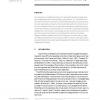Free Online Productivity Tools
i2Speak
i2Symbol
i2OCR
iTex2Img
iWeb2Print
iWeb2Shot
i2Type
iPdf2Split
iPdf2Merge
i2Bopomofo
i2Arabic
i2Style
i2Image
i2PDF
iLatex2Rtf
Sci2ools
PRESENCE
1998
1998
Navigating Large-Scale 'Desk-Top' Virtual Buildings: Effects of Orientation Aids and Familiarity
Two experiments investigated components of participants’ spatial knowledge when they navigated large-scale ‘‘virtual buildings’’ using ‘‘desk-top’’ (i.e., nonimmersive) virtual environments (VEs). Experiment 1 showed that participants could estimate directions with reasonable accuracy when they traveled along paths that contained one or two turns (changes of direction), but participants’ estimates were significantly less accurate when the paths contained three turns. In Experiment 2 participants repeatedly navigated two more complex virtual buildings, one with and the other without a compass. The accuracy of participants’ route-finding and their direction and relative straight-line distance estimates improved with experience, but there were no significant differences between the two compass conditions. However, participants did develop significantly more accurate spatial knowledge as they became more familiar with navigating VEs in general.
| Added | 23 Dec 2010 |
| Updated | 23 Dec 2010 |
| Type | Journal |
| Year | 1998 |
| Where | PRESENCE |
| Authors | Roy A. Ruddle, Stephen J. Payne, Dylan M. Jones |
Comments (0)

